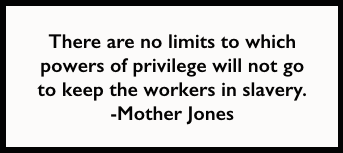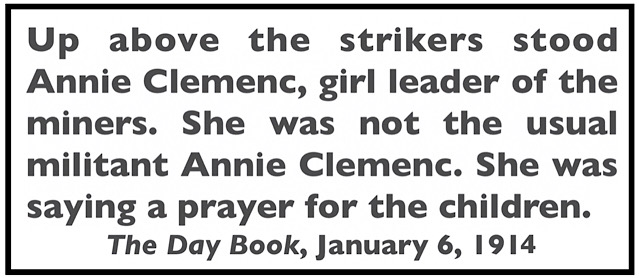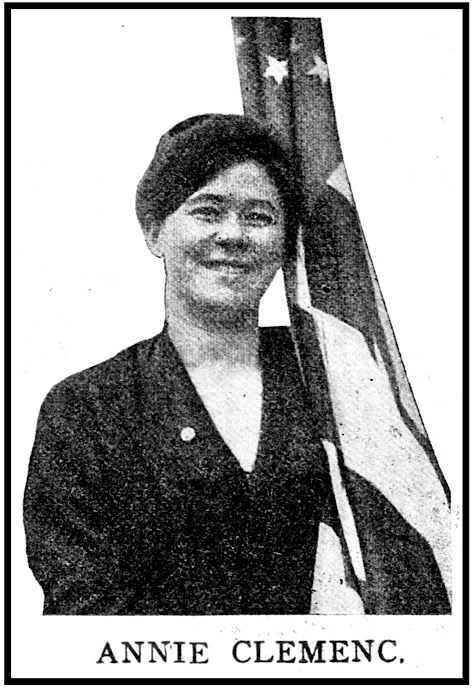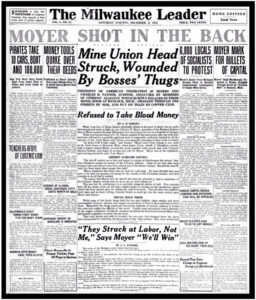 —————
—————
Hellraisers Journal – Friday January 16, 1914
Houghton, Michigan – Cheering Crowd Meets Moyer and Tanner at Station
From the Miners Magazine of January 15, 1914:
From the Miners’ Bulletin of January 9, 1914:
 —————
—————
Hellraisers Journal – Friday January 16, 1914
Houghton, Michigan – Cheering Crowd Meets Moyer and Tanner at Station
From the Miners Magazine of January 15, 1914:
From the Miners’ Bulletin of January 9, 1914:
 —————
—————
Hellraisers Journal – Friday January 9, 1914
Chicago, Illinois – President Moyer after Operation with Walker, Terzich and Riley
From Miners Magazine of January 8, 1914:
 —————
—————
Hellraisers Journal – Tuesday January 6, 1914
Calumet, Michigan – Mothers, Fathers, Sisters, Brothers Follow Small White Caskets
From the Chicago Day Book of January 6, 1914:
MOVIES SHOW GHASTLINESS OF CALUMET’S
RECENT FIRE CATASTROPHE[by Editor N. D Cochran]
[Note: There was no fire; the stampede to the stairway was caused by a man, wearing a Citizens Alliance button, who intentionally raised a false alarm of fire.]
There were two exhibitions of the moving pictures of the funeral of the victims of the Christmas eve disaster in Calumet yesterday.
In the little hall up three flights of stairs on North Clark street the picture received its baptism.
Its sponsors were two members of the Western Federation of Miners, three motion picture operators-one of whom had taken the picture-a picture producer, two newspapermen and an express wagon driver who had wandered into the darkened, bare hall, and stayed to watch the film unreeled, held by the power of the spectacle presented.
In the comments of the spectators was revealed the appeal of the picture.
Scenes of disaster, of misery and suffering were no strangers to those present. But the pathos of the picture pierced the veneer of cynicism and struck home.
With a flare and sputter the picture flashed on the little screen, revealing the church at which the service for the 57 victims buried was held.
Hundreds milled around the doors struggling to gain an entrance. Children predominated in the crowd, seeking to pay a final tribute to their playmates, whose lives had been so needlessly crushed out because someone had made a fatal blunder or worse.
A fine snow was falling, and the streets were covered with white. But the picture was wonderfully clear.
“Good stuff,” commented one of the picture men. “Notice how those buildings in the background stand out?”
An interurban car wormed, its way through the crowd which choked the street.
“H–l! Don’t them street car people there care nothing for a funeral,” came from the expressman, not conscious that he was speaking aloud.
A quick change in the picture, and the first coffin was brought from the church door. It was white and small. Nearly all of the coffins were white and small.
On the shoulders of four men the little box was borne down the steps of the church and placed in a waiting hearse. Another followed. And then another. They came in such quick succession that they could not be counted.
The supply of hearses ran out. And then came the most moving part of the picture. Two squads of four men each were assigned to a coffin and the coffin was carried aloft on their shoulders. When one squad tired another leaped to take its place.
A second street car sundered the head of the cortege as it started on its long march to the burying ground.
A quick transformation, and the scene changed to the funeral procession nearing the cemetery. Down the narrow ribbon of road it came, across the plain from Calumet. The road was a mass of black against the snowy wastes of the surrounding country.
Hearse after hearse passed. Some of the bodies were conveyed in sleighs. And then came the men marching with the coffins on their shoulders. They were carried two abreast.
Across the sky line was a smudge of smoke from one of the Calumet & Hecla mines. While the strikers were burying their dead the work of the mines went on. In the foreground loomed the shaft of the Red Jacket mine, where, many of the men had toiled before they went on strike.
“That sky line stuff is great,” commented one of the picture, operators “You can see people clear back to the town, and it must be a couple of miles away.”
“Yet they say there are only 3,000 of us on strike,” muttered Yanco Terzich, member of the miners’ union, who has guarded the film since it was brought from Calumet. “Look at those people. There are 15,000 in line. There would have been more, but they didn’t have the railroad fare. They have to eat.”
Following the last coffin came the women, the mothers of the children whose bodies were being borne on ahead. In a solid mass they marched, thousands of them. Many were weeping. Children clung to their hands, sobbing for sisters or brothers who were lying in the little white caskets carried on the shoulders of the men.
And then came the strikers. They were grim, tight-lipped, looking straight ahead toward the burying ground. At their head was a woman carrying an American flag shrouded in black.
Anarchists these men have been called. But they marched behind the flag that the militiamen had tried to take from them. They did not look like anarchists. They seemed to be very ordinary men, bundled in their fur caps and great coats.
On they came. When the head of the procession reached the cemetery the rear was still resting in the city.
A close view of the two trenches in which the bodies were laid was thrown on the screen. Up above the strikers stood Annie Clemenc, girl leader of the miners. She was not the usual militant Annie Clemenc. She was saying a prayer for the children.
The picture machine sputtered and the screen went dark. The reel of film had been run.
“That’s great stuff,” said one of the reporters. “But how are you going to write about it? How can you make people feel that picture by hammering a typewriter. They’ve got to see it. It’s too big for me.”
And it is too big. You do have to see it. It is like nothing ever pictured before.
Later the film was taken to the city hall to be passed on by the board of censors, of which Police Sergt. Jerry O’Connor is chief.
It was run so they might approve, which they did.
“There’s nothing harmful in that picture,” was O’Connor’s verdict. “But I think it is too long.”
It is too long-too pitifully long-though not in the way O’Connor meant.
[Photograph and emphasis added.]
Up above the strikers stood Annie Clemenc,
girl leader of the miners.
She was not the usual militant Annie Clemenc.
She was saying a prayer for the children.
The Day Book, January 6, 1914

On July 23, 1913, 9,000 copper miners of the Keweenaw Peninsula, Upper Michigan, laid down their tools and walked off the job. They were led by the great Western Federation of Miners, and they had voted by a good majority for a strike: 9,000 out of 13,000. The main issues were hours (the miners wanted an eight hour day), wages, and safety. The miners hated the new one-man drill which they called the “widow-maker.” They claimed this drill made an already dangerous job more dangerous.
The mining companies had steadfastly refused to recognize the Western Federation of Miners in any way. They would continue to refuse all efforts at negotiation or arbitration, even those plans for arbitration which did not include the union, and this despite the best efforts of Governor Ferris, and the U. S. Department of Labor. James MacNaughton, general manger of Calumet and Hecla Mining Company, famously stated that grass would grow in the streets and that he would teach the miners to eat potato parings before he would negotiate with the striking miners.
The Keweenaw Peninsula was a cold, windy place, jutting out into Lake Superior from the Upper Peninsula of Michigan. This area was known as the Copper Country of Michigan and included Calumet Township of Houghton County, with the twin towns of Hancock and Houghton ten miles to the south. Calumet Township included the villages of Red Jacket and Laurium.
It was here in Red Jacket, on the third day of the strike that Annie Clemenc, miner’s daughter and miner’s wife took up a massive America flag and led an early morning parade of 400 striking miners and their families. Annie Clemenc was six feet tall, and some claimed she was taller than that by two inches. The flag she carried was so massive that it required a staff two inches thick and ten feet tall. The miners and their supporters marched out of the Italian Hall and through the streets of the Red Jacket to the Blue Jacket and Yellow Jacket mines. They marched silently, without a band, lined up three and four abreast. These early morning marches, with Annie and her flag in the lead, were to become a feature of the strike.
 —————
—————
Hellraisers Journal – Wednesday December 31, 1913
Calumet, Michigan – Little White Caskets Carried Two Miles to Lakeview Cemetery
From the Michigan Miners’ Bulletin of December 31, 1913:
 —————
—————
Hellraisers Journal – Tuesday December 30, 1913
Calumet, Michigan – Mourners Carry Little White Caskets Two Miles to Cemetery
From The Altoona Times (Pennsylvania) of December 29, 1913:
PATHETIC INCIDENTS BRING TEARS
TO BYSTANDERS EYES
———-
Afflicted Mothers and Fathers Overcome
by Appalling Grief as Cortege Passes
———-CALUMET, Mich., Dec. 28. -The Western Federation of Miners buried its dead today. Fifty-nine bodies, including those of forty-four children, were carried through the streets down a winding country highway and laid in graves in a snow-enshrouded cemetery within sight of Lake Superior.
Thousands of saddened miners formed an escort to the funeral parties and passed between other thousands who as spectators testified to the grief that has oppressed the community since seventy-two men, women and children were killed in the Christmas eve panic in Italian hall.
For hours the Sabbath calm was broken by the tolling of bells and the sound of voices intoning burial chants. In half a dozen churches services were held earlier in the day and the mourners went about the streets, passing from their homes to the churches, back to their homes after brief respites and again to the churches to prepare for the last sad trip to the grave sides.
UNION HOSTS ASSEMBLED
Delegations of strikers began coming to Calumet early in the day. The special train of nine coaches brought hundreds of Federationists from the iron mines of Negaunee and Ishpeming and every town and mining location in the copper country sent members and friends of the union to swell the ranks of the marchers in the afternoon.
By noon the union host was assembled. Months of experience in demonstrating their numbers by parading had taught the men to form ranks quickly and with little delay they lined up four abreast.
The supply of hearses was inadequate and there were only fourteen of these vehicles in the van. Then came three undertakers’ wagons and an automobile truck, the latter carrying three coffins. These vehicles contained the adult victims and the older children. Beside one marched eight women, who acted as pall bearers, for members of the Women’s auxiliary of the Western Federation.
It was this woman’s organization which was distributing gifts of candy, shoes, caps and mittens to the children of strikers when the panic broke out.
STRIKERS CARRY COFFINS
Behind the hearses was a section of the procession which brought tears and sobs from onlookers. Thirty-nine white coffins, their size testifying to the short lite of the little forms within, were carried by relays of strikers. Four men bore each coffin, and as their arms grew weary or feet stumbled on the slippery roadway, companions relieved them of their burden.
Persons drawn to Calumet solely by curiosity became mourners as this contingent passed them. Men turned away to brush tears from their cheeks. Women,especially the mothers in the crowd, sobbed openly, and dozens, unable to endure the sight, rushed from the streets, taking refuge in homes whose Yuletide had been directly saddened by death. Others, too, were in evidence among the toil-hardened men who carried the coffins. They bore the bodies of their companions’ children and many a rough sleeve was brushed hurriedly across downturned faces, the eves of which were concealed by peaked caps drawn far forward.
CORTEGE TWO MILES LONG
Fifty singers chanted hymns in the wake of the children carriers. Most of these men were English miners, who had learned in Cornwall to chant Christmas carols in the streets and years ago brought this old custom to the copper country. Today, however, they didn’t sing songs of a new life born. “Jesus Lover of My Soul,” “Rock of Ages” and “Nearer My God to Thee” came from throats thick with emotion. But the harmonies were full and rich.
 —————
—————
Hellraisers Journal – Monday December 29, 1913
Chicago, Illinois – W. F. of M. President Charles Moyer Expected to Recover
From The Day Book of December 29, 1913:
———-
———-
———-
 —————
—————
Hellraisers Journal – Sunday December 28, 1913
Calumet, Michigan – Men, Women and Children Perish in Midst of Christmas Joy
From the Michigan Miners’ Bulletin of December 28, 1913:
In the midst of Christmas good cheer and happiness twenty eight little girls, twenty four little boys, fifteen women and five men were swirled into the cruel jaws of death in less than five minutes at the Italian hall, Calumet, on Christmas eve. The striking miners of Calumet had prepared Christmas exercises and the distribution of presents for the little ones and at the appointed time the hall was filled with the happy little tots accompanied by their parents. The Christmas tree gaily decorated and loaded with presets stood upon the stage of the hall. The program was started by Mrs. Annie Clemenc who was making a talk to the children telling them that old Santa had not forgotten them just because their fathers had been denied work, and that they were all to be made happy by receiving many nice presents, candies, fruits and nuts.
The little ones had crowded near the stage their little faces beaming with delight when a fiend in the shape of a man sneaked up the stairway leading to the hall, opened the door and waving his arm cried “fire, fire,” then quickly making his way to the street where he disappeared in the gathering darkness. At the cry of fire the great throng arose as one and made a dash for the front exit of the hall. The way was made for the children first and they filled the stairway so full and crowded from the rear so fast that some of the children were swept off their feet. These little bodies acted a stumbling blocks for those who followed and within a few seconds the stairway was a mass of bleeding crushed, dead and dying humanity. The crowd from above kept crowding into the stairway until it was completely filled with bodies.
As soon as the cry of fire had been sounded the city fire alarm was bellowing its harrowing warning and the firemen upon arriving at the scene quickly placed ladders to the front windows of the building and ascended to the hall where they stopped any more from crowding into the stairway upon the dead bodies of their comrades. Within a few minutes the hall had been emptied and the work of removing the dead taken up. The bodies were so tightly wedged into the hallway that they could not be released below and had to be taken from above and carried back into the hall. The bodies were taken to a temporary morgue in the city hall where after identification they were sorrowfully removed to their homes.
The scene was one beggaring description and those who witnessed it will never have it effaced from their minds as long as they live. While the front hallway was being crowded and jammed full of men, women and children others were seeking escape at a fire exit in the rear of the hall, many getting out in this manner. Others jumped from windows and in nearly every instance were severely injured, one little boy who jumped had both legs broken.
One little girl who was jammed in the hallway in a dying condition begged one of the rescuers to save her. She grasped his hand, kissed it, then her little head dropped upon her breast and she was dead. One man whose name was not learned got in the hallway and tried to prevent the frenzied crowd from crowding down the stairs upon those below. He placed his arms across the hall way and checked them momentarily but the force behind became too great and he was swept into the vortex of death, his dead body being taken out a few minutes later. Holding high above her head her little child, a woman and her husband were carried into the mass of humanity trying to get out of the hall. This man and his wife were swept to their death but the child miraculously escaped.
The fiend who caused this terrible disaster made his escape and is still at large. From persons who stood near the door it is learned that he was rather stockily built, a little under medium height, and wore his hat well pulled down over his countenance. Upon the lapel of his coat he wore a Citizens Alliance button, is a statement made by several who got a good view of him. How anyone with reasoning power could have deliberately committed the act is beyond comprehension.
President Moyer of the Federation who was in Hancock at the time of the accident hurried to Calumet and assured those afflicted that their wants would be attended to by the organization at whose head he stands. The funerals of the victims will be held at Calumet this afternoon and will be attended by thousands of sorrowing friends and companions of those who, while in life, stood valiantly by their side in the great fight for justice which still holds within it grasp the entire district. The funerals will be held under the auspices of organized Labor, and no funds other than those donated by such organizations will be accepted. Organized labor has made this request and the wishes will be respected in this matter…..
[Emphasis and paragraph breaks added.]
 —————
—————
Hellraisers Journal – Saturday December 27, 1913
Hancock/Houghton, Michigan – Moyer and Tanner Kidnapped and Deported
 Last night at about 8:30 p.m. Sheriff Cruse and a “committee” paid a visit to the Scott Hotel in Hancock. They went to the room of Charles Moyer, President of the Western Federation of Miners. The “committee” was determined that the leaders of the W. F. of M. should reconsider their refusal to accept any donations from the Citizens’ Alliance to the families of the victims of the Italian Hall Massacre. Mr. Moyer remained adamant that donations from the Citizens’ Alliance amounted to blood money and that the union would bury it’s own dead.
Last night at about 8:30 p.m. Sheriff Cruse and a “committee” paid a visit to the Scott Hotel in Hancock. They went to the room of Charles Moyer, President of the Western Federation of Miners. The “committee” was determined that the leaders of the W. F. of M. should reconsider their refusal to accept any donations from the Citizens’ Alliance to the families of the victims of the Italian Hall Massacre. Mr. Moyer remained adamant that donations from the Citizens’ Alliance amounted to blood money and that the union would bury it’s own dead.
No sooner had this “committee” left the room than a mob burst into the room. They began to beat Moyer and also Charles Tanner who was there with him. A gun was used to beat Moyer over the head which discharged during the assault. Moyer was shot in the shoulder. Moyer and Tanner were dragged out of the Hotel and down the street to the train station in Houghton. At the Houghton-Hancock bridge they were threatened with hanging, and shown a noose brought for that purpose.
The kidnappers put Moyer and Tanner on the Chicago train. Deputy Sheriff Hensley and Deputy McKeever were assigned to accompany the deportees. The deputies wore their Citizens’ Alliance buttons right next to their deputy badges for all to see.
The train stopped briefly in Milwaukee, and reporters were able to get the story from Moyer and Tanner. The reporters also witnessed Moyer’s “pillow and bed linen were soiled with blood from wounds in his scalp and back.”
———-
From the Chicago Day Book of December 27, 1913, Noon Edition
 —————
—————
Hellraisers Journal – Friday December 26, 1913
Strikers’ Children of Calumet Murdered as Sacrificial Slaughter to Capitalism
From Työmies of December 26, 1913: